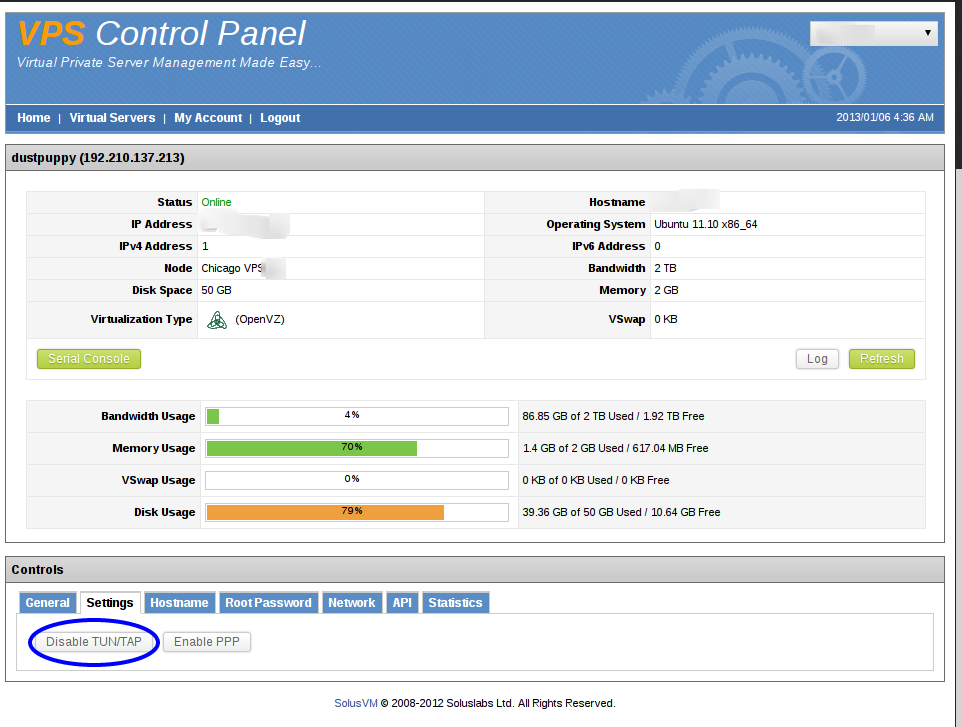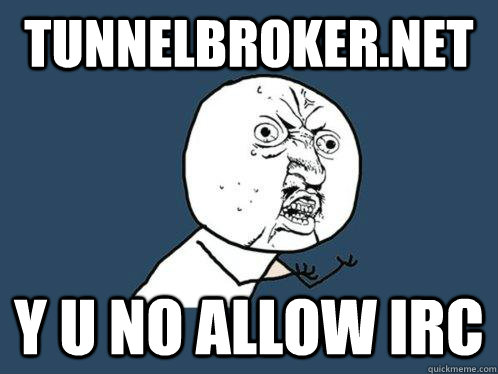I have recently moved my hosting to a couple of VPSes at ChicagoVPS and wanted to use IPv6 tunnelbroker.net
ChicagoVPS uses OpenVZ which presents a couple of problems
$ ifconfig sit0
sit0: error fetching interface information: Device not found
$ sudo modprobe ipv6
FATAL: Module ipv6 not found.
It turns out, this is a fairly common problem though OpenVZ is supposed to support IPv6. Luckily, someone made a small userland program tb-tun, which “tunnels” IPv6 tunnels through a TUN/TAP device.
First, it requires tun/tap device support to be enabled in the VPS, this is done in the control panel under settings

Note! Changing this setting will reboot your VPS without warning!
Next, make sure the build-essential package is installed (it’s included in the Ubuntu template at ChicagoVPS)
$ sudo apt-get install build-essential
Now, download and install the tb-tun program
$ mkdir tb-tun
$ cd tb-tun
$ wget https://tb-tun.googlecode.com/files/tb-tun_r18.tar.gz
$ tar zxvf tb-tun_r18.tar.gz
$ gcc tb_userspace.c -l pthread -o tb_userspace
$ sudo mv tb_userspace /usr/local/sbin
Before, continuing I recommend looking up the following information:
Next, you need to ensure your iptables configuration allows incoming encapsulated IPv6 traffic (protocol 41). Since ufw is a PITA to get to work on OpenVZ, I’m using iptables-persistant, which simply means adding one line to /etc/iptables-persistent/rules.v4
# IPv6 tunnel
-A INPUT -p 41 -s <Server IPv4 Address> -j ACCEPT
You also need to secure your server on IPv6, /etc/iptables-persistent/rules.v6
*filter
-A INPUT -i lo -j ACCEPT
-A INPUT -m state --state RELATED,ESTABLISHED -j ACCEPT
# Allow ping
-A INPUT -p ipv6-icmp -j ACCEPT
-A INPUT -p tcp --dport 80 -j ACCEPT
-A INPUT -p tcp --dport 443 -j ACCEPT
-A INPUT -j DROP
-A FORWARD -j DROP
COMMIT
Apply the new rules
$ sudo service iptables-persistent reload
Finally, you are ready to set up your tunnel in /etc/network/interfaces
auto tb
iface tb inet6 manual
pre-up setsid /usr/local/sbin/tb_userspace tb <Server IPv4 address> <Client IPv4 address> sit > /dev/null &
up ifconfig tb up
post-up ifconfig tb inet6 add <Client IPv6 address>/64
post-up ifconfig tb inet6 add <Routed /64>:1/64
post-up ifconfig tb mtu 1480
post-up route -A inet6 add ::/0 dev tb
post-up netstat -rn6 | grep -q venet0 && route -A inet6 del ::/0 dev venet0
down ifconfig tb down
post-down route -A inet6 del ::/0 dev tb
post-down killall tb_userspace
In my setup it looks like this:
auto tb
iface tb inet6 manual
pre-up setsid /usr/local/sbin/tb_userspace tb 209.51.181.2 192.210.137.214 sit > /dev/null &
up ifconfig tb up
post-up ifconfig tb inet6 add 2001:470:1f10:74b::2/64
post-up ifconfig tb inet6 add 2001:470:1f11:74b::1:1/64
post-up ifconfig tb mtu 1480
post-up route -A inet6 add ::/0 dev tb
post-up netstat -rn6 | grep -q venet0 && route -A inet6 del ::/0 dev venet0
down ifconfig tb down
post-down route -A inet6 del ::/0 dev tb
post-down killall tb_userspace
Now, I just have one question

(Actually I know, and understand, why. It’s still annoying though)